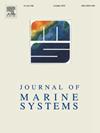基于深度学习的东海浙闵沿海锋冬季时空变化
IF 2.5
3区 地球科学
Q2 GEOSCIENCES, MULTIDISCIPLINARY
引用次数: 0
摘要
海洋锋区混合剧烈、生产力高、渔业资源丰富,对海洋生态环境具有重要意义。本文针对传统海锋梯度算法的不足,采用Belkin O'Reilly算法和深度学习网络相结合的方法,从遥感海温(SST)图像中识别出东海浙民海锋(ZMCF)。环形残余U-Net网络在检测ZMCF方面表现出色,特别是在不连续,碎片化和多分支前沿。通过对ZMCF区域的探测,分析了冬季ZMCF海温梯度、锋面概率和离岸距离的月变化。利用经验正交函数(EOF)方法捕捉了ZMCF概率时空变化的主导模态,表明ZMCF的跨岸运动与北风强度密切相关。在La Niña年太平洋年代际涛动低相条件下,增强的ZMCF被困在海岸附近,受强烈的偏北风驱动。El Niño事件则产生相反的效果。本文章由计算机程序翻译,如有差异,请以英文原文为准。
Spatiotemporal variations in Zhe-Min Coastal Fronts in the East China Sea in winter by deep learning
Oceanic fronts are crucial for marine ecology and the environment due to their vigorous mixing, high productivity, and abundant fishery resources. In this study, the Zhe-Min Coastal Front (ZMCF) in the East China Sea is identified from remote sensing Sea Surface Temperature (SST) images using a combination of the Belkin O'Reilly Algorithm and a deep learning network, addressing the shortcomings of traditional front gradient algorithms. The Ringed Residual U-Net network excels in detecting the ZMCF, particularly in discontinuous, fragmented, and multi-branch fronts. After detecting the ZMCF areas, the monthly variations in SST gradient, front probability, and offshore distance of the ZMCF are analyzed for winter. An empirical orthogonal function (EOF) method is employed to capture the dominant mode of spatiotemporal variations in the ZMCF probability, demonstrating that the cross-shore movement of the ZMCF is closely related to the magnitude of the northerly wind. Under the conditions of the low phase of the Pacific Decadal Oscillation, the intensified ZMCF is trapped near the coast, driven by strong northerly wind during La Niña years. El Niño events exert the opposite effect.
求助全文
通过发布文献求助,成功后即可免费获取论文全文。
去求助
来源期刊

Journal of Marine Systems
地学-地球科学综合
CiteScore
6.20
自引率
3.60%
发文量
81
审稿时长
6 months
期刊介绍:
The Journal of Marine Systems provides a medium for interdisciplinary exchange between physical, chemical and biological oceanographers and marine geologists. The journal welcomes original research papers and review articles. Preference will be given to interdisciplinary approaches to marine systems.
 求助内容:
求助内容: 应助结果提醒方式:
应助结果提醒方式:


